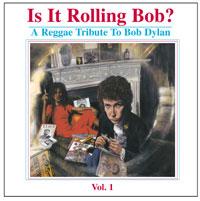Dylan Done Dub: a Reggae Tribute to Zimmerman
The cover art, a Rasta remake of Dylan's Bringing It All Back Home painted by Eric White, hits all the right notes and promises a good time. Bob's rolling a number, pout-faced into the camera, a bottle of Red-Stripe's on the mantle along with a portrait of the other Bob, and the LP's splayed out on the couch are the soundtrack to The Harder They Come, Bob Marley Live and Desmond Dekker and the Aces's Israelites, containing the hit single which was the first ska/reggae tune heard by most Americans, along with Peter Tosh's Wanted and one additional LP I don't know. There are images of Haile Sellasie on magazine covers, and even a Wailers poster from Wolf and Rissmiller's Country Club a Reseda, CA night spot.
The artists include Toots Hibbert, Beres Hammond, The Mighty Diamonds, Gregory Isaacs and some younger Reggae stars doing Dylan classics like “The Times They Are a Changin',” “Maggie's Farm,” “Lay, Lady Lay,” “Knockin' on Heaven's Door,” etc. and the set was recorded in Kingston. Even the title and the opening few seconds, the famous opening to Nashville Skyline where veteran producer Bob Johnston calls out “Is it Rolling Bob?” portend a nourishing set.
Unfortunately, the set's mostly a boring bust. Starting with a long, flat, never seems to end reading of “The Times They Are a A-Changin'” by Apple Gabriel Is it Rolling Bob? manages to simultaneously trivialize Reggae and Bob Dylan. Now that's a major accomplishment but not one to be proud of.
What's wrong? The backing tracks are uninspired and sometimes insipid renderings of the Reggae form with very little of the genre's intent to back it up. It's just empty. The music's attractive rubbery, sticky quality is missing, leaving “the beat” as a monotonous, repetitive and occasionally corny backdrop for mostly lackluster readings of great songs-and that's despite Sly Dunbar on drums. No one sounds inspired.
Even the liner notes' attempts to draw parallels between Dylan and Marley and to recast the lyrics as referring to Jamaican cultural issues are a stretch-though they were written by Roger Steffens, a Marley expert.
The only artists who seem to connect with Dylan's musical spirit are Nasio Fountaine (“Gotta Serve Somebody”), Luciano (“Knockin' on Heaven's Door”) and Black Uhuru lead singer Michael Rose (“The Lonesome Death of Hattie Carrol”). Toots Hibberts's “Maggie's Farm” doesn't catch fire and Gregory Isaacs's “Mr. Tambourine Man” is just plain flat. Maybe it has to do with the basic sweetness and sincerity of the Jamaican culture. Finally there's a dub version of “I and I” (fromInfidels), which originally featured Sly and Robbie (along with Mark Knopler and Mick Taylor). It's the first time Dylan has allowed one of his performances to be “dubbed” and it's the one track that cuts through to Dylan's intentions because it's sung by Dylan. The “dubbing” isn't severe, either-mostly echo trails added at the end of the chorus lines. Side 4 includes heavily reworked dub versions of five of the tunes that in some ways are more interesting than the vocal editions.
Sonics are pretty good: direct and to the point, though somewhat crunchy. Bass is deep and tight, especially on the dub editions.
Maybe I'm being too hard on this set, but overall I was disappointed by the lack of fire and inspiration through most of it. I realize there's a lost tribe of Israel connection to reggae, but when the music resembles a Bar Mitzvah band, something's just not right!



